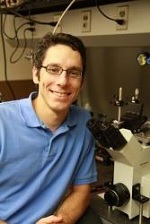 |
| UCSC's Michael Stone |
Scientists at UC Santa Cruz have identified a key structural component of the telomerase enzyme that can contribute to cell proliferation in cancer cells, publishing their findings in Nature Structural and Molecular Biology. And they say that the work could help pave the way to a new, targeted cancer treatment that zeroes in on telomerase.
Telomeres are repetitive DNA sequences found at the ends of chromosomes, essential for cell longevity since they protect against the slow erosion of the chromosome that occurs with time. Telomerases are enzymes that lengthen telomeres by adding further repeat sequences to the end.
"Since the discovery of telomerase and its over-activation in cancers, people have recognized the huge therapeutic potential for anticancer drugs that target telomerase. But there still is no such drug in the clinic, and part of the reason is our lack of understanding of the detailed structure of the enzyme," Stone said.
Senior author of the study, Michael Stone, who also serves as associate professor of chemistry and biochemistry at UC Santa Cruz, with his team spotlighted the structure of a region of the telomerase called the RNA binding domain.
Telomerase enzymes contain a protein component (called reverse transcriptase) required to make DNA copies from RNA templates, and the RNA component which has the template for the copy of DNA sequence to be eventually added to the telomere.
"The template is the track that the enzyme runs along, and what's so unique with telomerase is that the track is an integral component of the enzymes itself." Stone said.
Although these two components have been previously annotated, Stone paves the way ahead with the characterization of the RNA binding domain--thought to tether one end of the RNA so that only a defined sequence can move through the active site of the reverse transcriptase. This helps to explain how the copied sequences are so accurately reverse transcribed to DNA.
"The reverse transcriptase is pulling on the RNA, but the structural resistance of the RNA binding domain prohibits the movement of more RNA, and that's how the template boundary is defined," Stone said.
They further show that the section of RNA tethered to the protein makes up a structure called an RNA stem loop. A protein structure in the binding domain fits at the base of the RNA stem which anchors the whole structure together. This enables subsequent reverse transcription of the same small RNA sequence.
"Our model is consistent with the findings of other studies of telomerase and directly reveals the functional mechanism involved," Stone said. "What makes this interesting for rational drug design is that template boundary definition is a very specific feature of telomerase. Our cells are full of other kinds of polymerase enzymes, so it's important to design a drug that targets only telomerase."
- here's the release